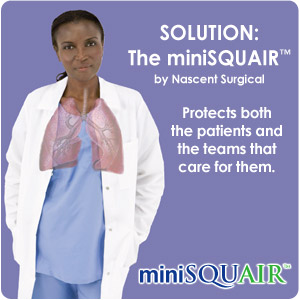Surgical Smoke
Surgical and anesthesia teams and operating room nurses recognize the offensive nature of operating room smoke, which is produced as a result of tissue vaporization. Surgical smoke, a necessary by-product of heat transfer technology, releases an odorous and noxious plume that contains a number of harmful irritants and known carcinogens.
Chronic exposure to these materials may lead to nausea, respiratory diseases as well as viral infections. The commonly used surgical mask does not offer adequate protection for the team against inhalation of minute particles present in the plume created during surgery.
View the Surgical Smoke Seminar Video
PROBLEM #1
The air in the O.R. is not safe for the entire O.R. Team or the Patient.
Why?
Surgical smoke, a necessary by-product of heat transfer technology, releases an odorous and noxious plume that contains a number of harmful irritants and known carcinogens such as benzene, formaldehyde, acrolein, and carbon monoxide as well as carbonized tissue, blood and intact viruses and bacteria.1 Chronic exposure to these materials may lead to nausea, respiratory diseases such as chronic bronchitis and sinusitis as well as viral infections such as condylomata. 2

PROBLEM #2
Patients under local anesthesia inhale the bioaerosol produced as a result of electrosurgery. 4
PROBLEM #3
Exposure to surgical smoke during pregnancy or by people with asthma or other pre-existing respiratory illnesses can have a negative effect.

PROBLEM #4
The commonly used surgical mask does not offer adequate protection for the team against inhalation of minute particles present in the plume created during surgery.
According to Kay Ball, PhD., RN and former chair of AORN’s Surgical Smoke Task Force, “Seventy-seven percent of what is in surgical smoke is 1.1 microns in size and smaller, so it can go right through a surgical mask and be deposited in the alveoli of your own lungs.” 5
PROBLEM #5
Absenteeism: The effect of inhaling surgical smoke can lead to increased absence that results in excessive overtime expenses to hospitals.
PROBLEM #6
The equipment currently available does not capture most of the O.R. smoke.
1 Ulmer, B. C. “The Hazards of Surgical Smoke.” AORN J. 2008; Apr. 87(4): 721-738.
2 Barrett, W.L., Garber, S. M. “ Surgical Smoke – A Review of the Literature.” Surg. Endosc. 2003; 17(6): 979-987.
3 Al Sahaf, O.S.; Vega-Carrascal, I.; Cunningham, F.O.; McGrath J.P.; Bloomfield, F.J. “Chemical Composition of Smoke Produced by High- Frequency Electrosurgery.” Ir J Med. Sci. 2007 Sept.;176(3):229-32.
4 Schultz, L.S., Drogue, J. “Unique Devices for Efficiently Removing Surgical Plume.” Surg Serv Manage. 2000 Apr; 6(4):8-12.
5 Stanton, C. “Taking a Stand on Surgical Smoke.” AORN Connections. April, 2008. http://www.AORN.org/news/April2008news/ takingastandonsurgicalsmoke/. Accessed November 24, 2010.


